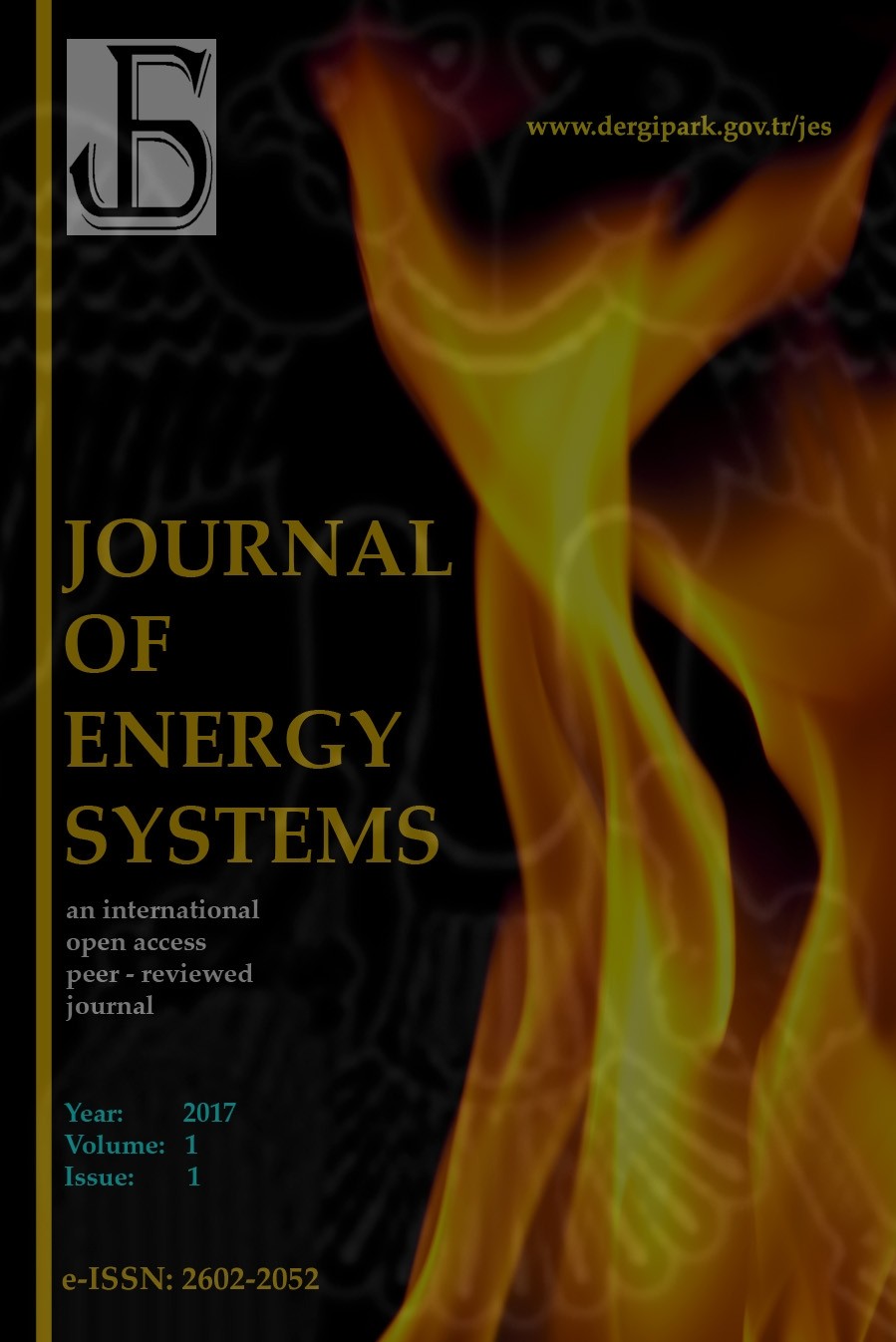Application of support vector regression integrated with firefly optimization algorithm for predicting global solar radiation
Application of support vector regression integrated with firefly optimization algorithm for predicting global solar radiation
Fire fly optimization algorithm Solar radiation, Statistical parameters, Support vector regression,
___
- Akikur, R, Saidur R, Ping, H, Ullah, K. Comparative study of stand-aloneand hybrid solar energy systems suitable for off-grid rural electrification: a review. Renewable Sustainable Energy Reviews 2013; 27(3):738-52.
- Kalogirou, SA. Artificial neural networks and genetic algorithms for the modeling, simulation and performance prediction of solar energy systems. Assessment and Simulation Tools for Sustainable Energy Systems. Green Energy and Technology 2013; 225–245.
- Fadare, DA. Modelling of solar energy potential in Nigeria using an artificial neural network model. Applied Energy 2009; 86:1410–22.
- Celik, E, Gor, H, Ozturk, N, Kurt, E. Application of artificial neural network to estimate power generation and efficiency of a new axial flux permanent magnet synchronous generator. International Journal of Hydrogen Energy, 2017; 42(28): 17692-17699.
- Celik, E, Uzun, Y, Kurt, E, Ozturk, N, Topaloglu, N. A neural network design for the estimation of nonlinear behavior of a magnetically-excited piezoelectric harvester. Journal of Electronic Materials, 2018; 47(8): 4412-4420.
- Celik, E, Cavusoglu, O, Gurun, H, E, Ozturk, N, Topaloglu, N. Estimation of the clearance effect in the blanking process of CuZn30 sheet metal using neural network−A comparative study. Bilişim Teknolojileri Dergisi, 2018; 11(2), 187-193.
- Ornella, L, Tapia, E. Supervised machine learning and heterotic classification of maize (Zea mays L.) using molecular marker data. Computers and Electronics in Agriculture 2010; 74: 250–257.
- Ananthakrishnan S, Prasad R, Stallard D, Natarajan P. Batch-mode semisupervised active learning for statistical machine translation, Comput. Speech Lang.2013; 17: 397–406.
- Wei Z, Tao T, ZhuoShu D, Zio E, A dynamic particle filter-support vector regression method for reliability prediction, Reliab. Eng. Syst. Safe. 2013; 11(9): 109–116.
- Chen, JL, Liu, HB, Wu, W, Xie, DT. Estimation of monthly solar radiation from measured temperatures using support vector machines-a case study. Renewable Energy 2011; 36: 413–420.
- Zeng, J, Qiao, W. Short-term solar power prediction using a support vector machine. Renewable Energy 2013; 52:118–127.
- Ekici, BB. A least squares support vector machine model for prediction of the next day solar insolation for effective use of PV systems. Measurement 2014; 50: 255–262.
- Solmaz, O, Ozgoren, M. Prediction of hourly solar radiationin six provinces in turkey by artificial neural networks. Journal of Energy Engineering 2012; 138, 194–204.
- Jiang, Y. Computation of monthly mean daily global solar radiation in China using artificial neural networks and comparison with other empirical models. Energy 2009; 1276–1283.
- Benghanem, M, Mellit, A, Alamri, S. ANN-based modelling and estimation of daily global solar radiation data: acasestudy. Energy Conversion and Management 2009; 50(7):1644–55.
- Mellit, A, Hadj, Arab, A, Khorissi, N, Salhi, H. An ANFIS-based forecasting for solar radiation data from sunshine duration and ambient temperature. In: IEEE power engineering society general meeting; 24–28 June 2007, Florida (USA). p. 1–6
- Bosch JL, Lopez G, Batllesa FJ. Daily solar irradiation estimation over a mountainous area using artificial neural networks. Renew Energy 2008;33(7):1622–8.
- Ramedani Z,Omid M,Keyhani A,Shamshirband S,Khoshne visan B. Potential of radial basis function based support vector regression for global solar radiation prediction.Renewable Sustainable Energy Rev2014;39(1):1005–11.
- Guzmán, SM, Paz, JO, Tagert, MLM, Mercer, AE, Pote, JW. An integrated SVR and crop model to estimate the impacts of irrigation on daily groundwater levels. Agricultural Systems 2018; 159: 248-259.
- Yang, XS. Firefly algorithm, stochastic test functions and design optimization. Journal Bio-Inspired Computation 2010; 2(2): 78–84.
- Kayarvizhy, N, Kanmani, S, Uthariaraj R. ANN models optimized using swarm intelligence algorithms. WSEAS Transactions on Computers 2014; 13: 501-519.
- URL1 < https://www.google.com/maps/@34.3808769,50.7895208,2502254m/data=!3m1!1e3?hl=en>
- Angstrom, A. Solar and terrestrial radiation. Quarterly Journal of the Royal Meteorological Society 1924; 50: 121-125.
- Prescott, JA. Evaporation from water surface in relation to solar radiation. Transactions of the Royal Society of South Australia. 1940; 64: 114–125.
- Bristow, KL, Campbell, GS. On the relationship between incoming solar radiation and daily maximum and minimum temperature. Agricultural and Forest Meteorology. 1984; 31: 159-166.
- Elagib, N, Mansell, MG. New approaches for estimating global solar radiation across Sudan. Energy Conversion and Management 2000; 41: 419-434.
- Chen, RS, Ersi, K, Yang, JP, Lu, SH, Zhao, WZ. Validation of five global radiation models with measured daily data in China. Energy Conversion and Management 2004; 45: 1759-1769.
- Samadianfard, S, Sattari, MT, Kisi, O, Kazemi, H. Determining flow friction factor in irrigation pipes using data mining and artificial intelligence approaches. Applied Artificial Intelligence 2014; 28: 793-813.
- Kurup, PU, Dudani, NK. Neural networks for profiling stress history of clays from PCPT data. Journal of Geotechnical and Geoenvironmental Engineering 2014; 128(7): 569-579.
- Pal, M. Support vector machines-based modelling of seismic liquefaction potential. International Journal for Numerical and Analytical Methods in Geomechanics 2006; 30(10): 983-996.
- Samadianfard, S, Delirhasannia, R, Kisi, O, Agirre-Basurko, E. Comparative analysis of ozone level prediction models using gene expression programming and multiple linear regression. GEOFIZIKA 2013, 30, 43-74.
- Başlangıç: 2017
- Yayıncı: Erol KURT
Mathematical modeling of an innovative hybrid solar-gas dryer
Ahmed ZOUKİT, Hicham EL FEROUALİ, İssam SALHİ, Said DOUBABİ, Naji ABDENOURİ
A comparative CFD analysis of NACA0012 and NACA4412 airfoils
Mustafa YILMAZ, Hasan KÖTEN, Erkan ÇETİNKAYA, Ziya COŞAR
The cost of electromechanical equipment in a small hydro power storage plant
Abdulhalim AŞKAN, Selim TANGÖZ
Digital industrial furnaces: Challenges for energy efficiency under VULKANO project
Juan Carlos ANTOLÍN-URBANEJA, Asier GONZÁLEZ-GONZÁLEZ, Jose Manuel LOPEZ-GUEDE, Jesús LÓPEZ DE IPİÑA
Saeed SAMADİANFARD, Salar JARHAN, Hamed SADRİ NAHAND
Morteza NAZARİ-HERİS, Behnam MOHAMMADİ-IVATLOO, Somayeh ASADİ
CFD Modeling and Multi-Objective Optimization of the Axial Fan Parameters
Potential of biogas energy from animal waste in the Mediterranean Region of Turkey
Investigation of effect of vehicle grilles on aerodynamic energy loss and drag coefficient
